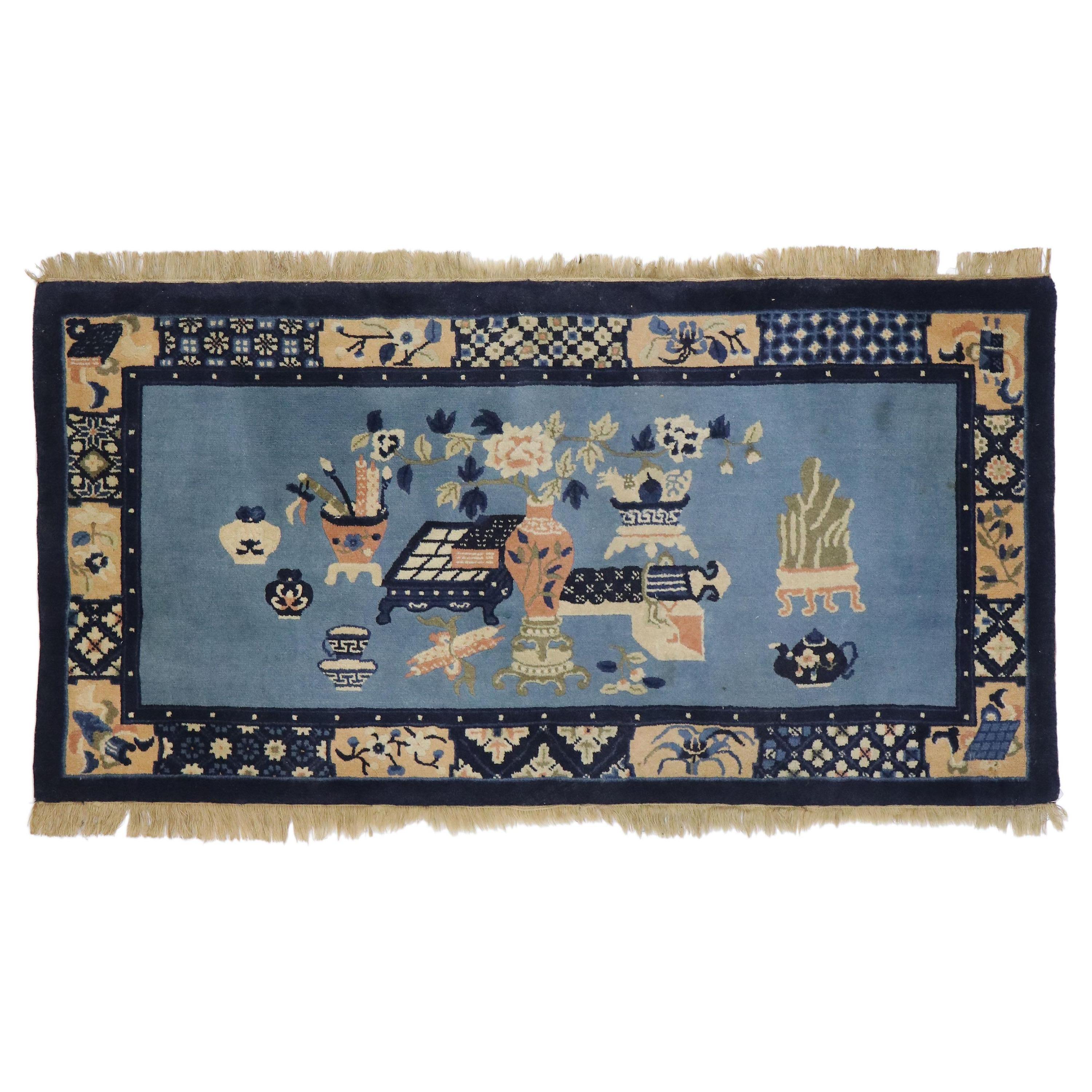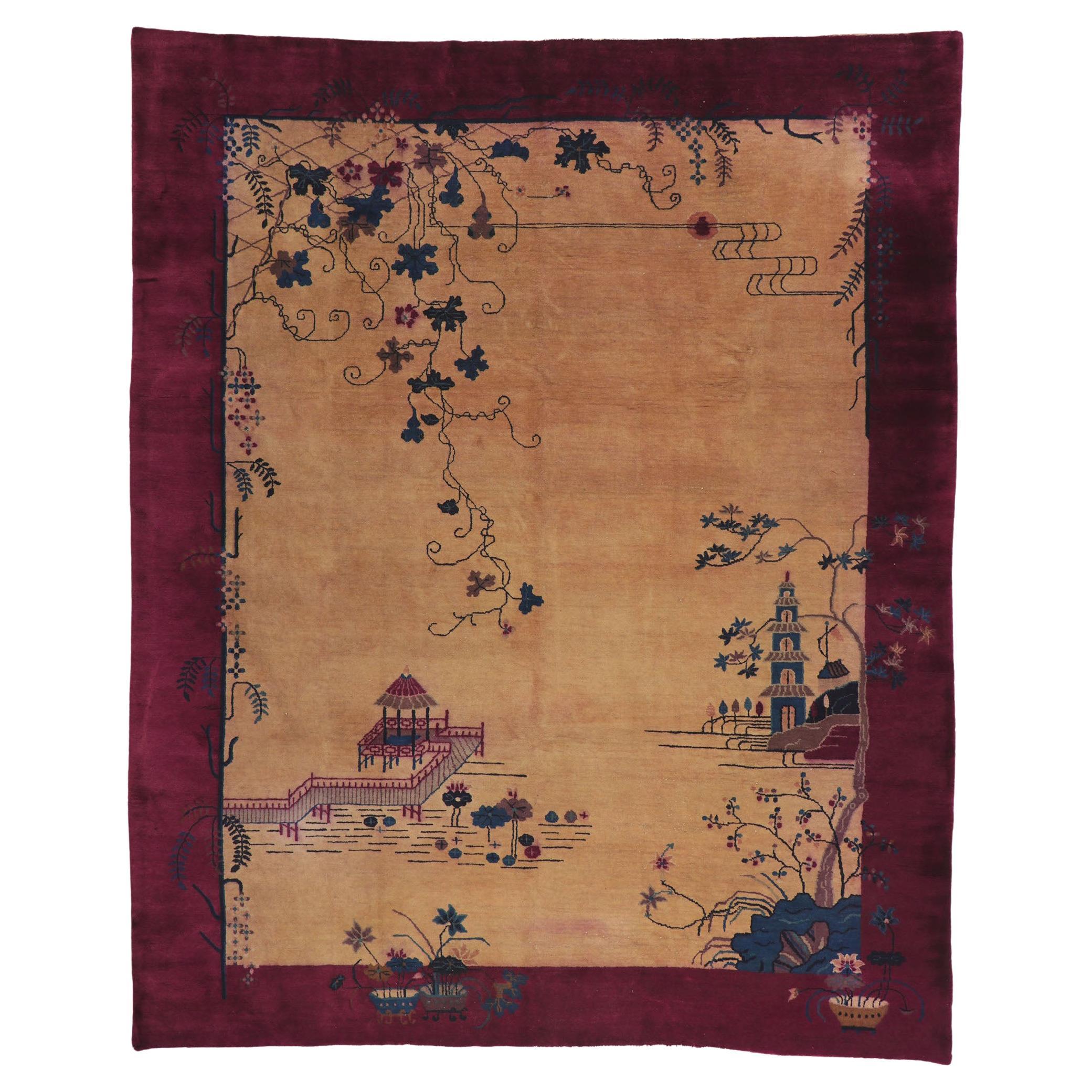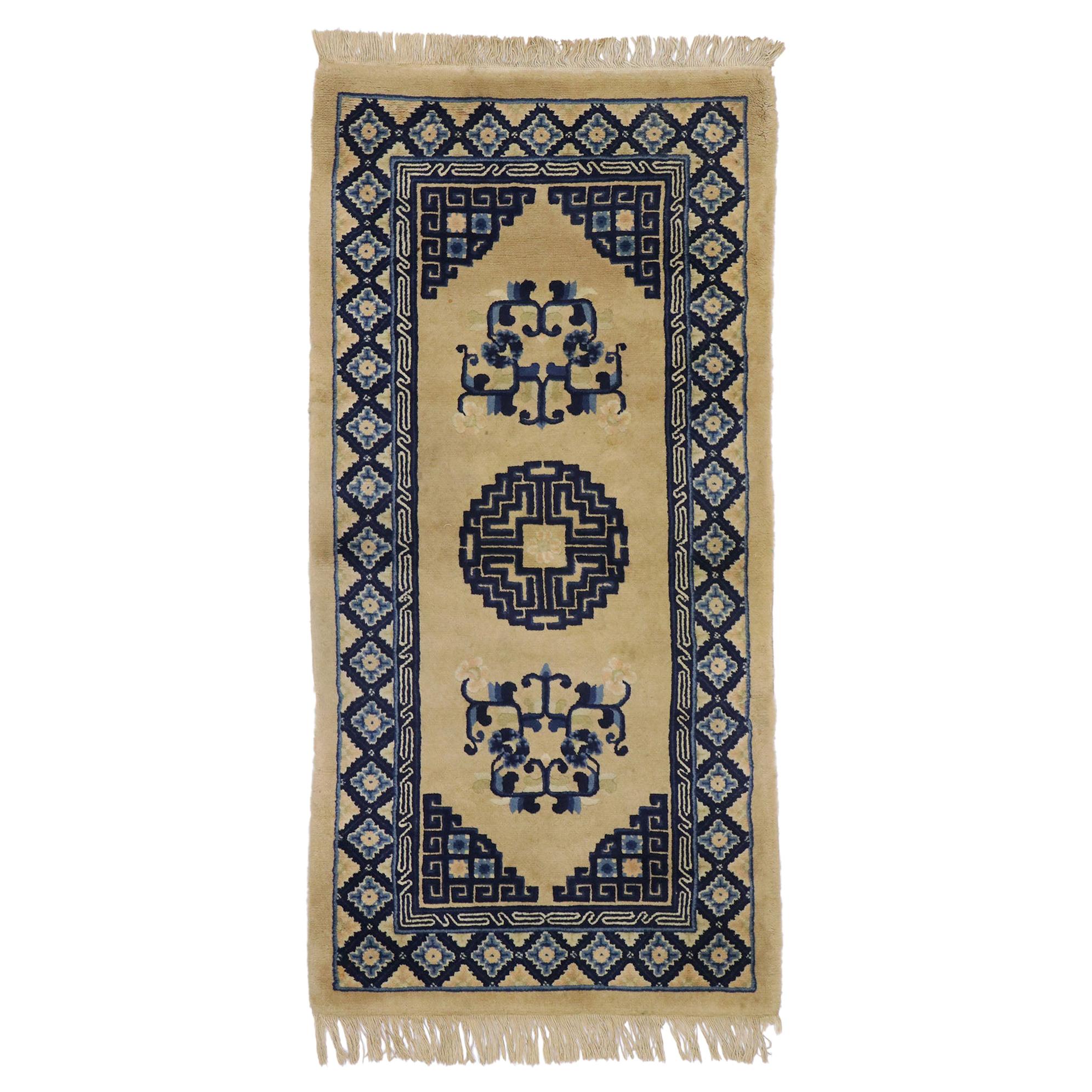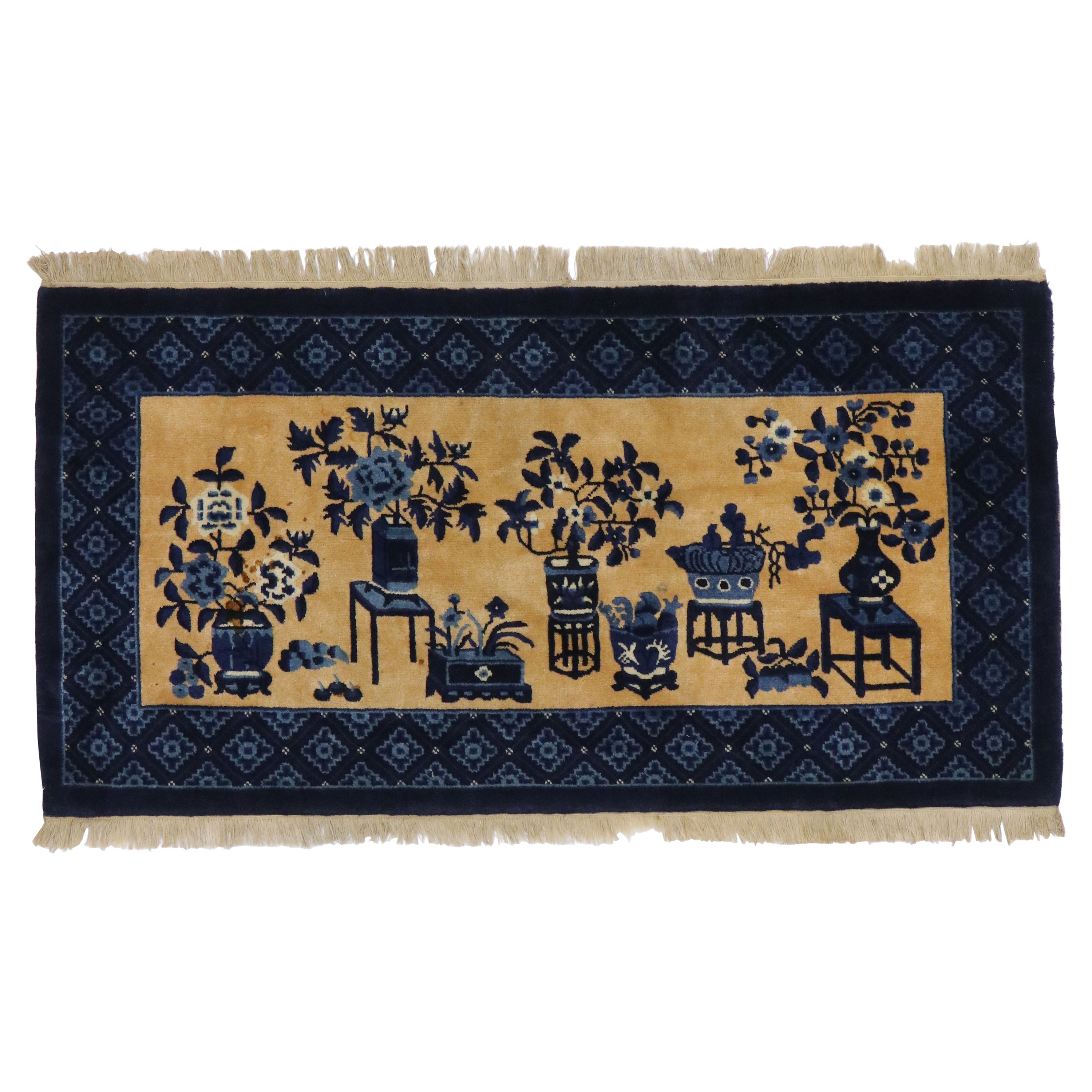Items Similar to Antique Chinese Art Deco Baotou Rug with Scholar Pictorial
Want more images or videos?
Request additional images or videos from the seller
1 of 10
Antique Chinese Art Deco Baotou Rug with Scholar Pictorial
About the Item
78185 Antique Chinese Art Deco Rug, 10'02 x 11'07. This hand-knotted wool antique Chinese pictorial rug features a colorblock field design. With its cold, arid climate ideal for raising sheep, Baotou, a city in the Inner Mongolia region of China, was a major weaving center known for producing high-quality wool. The city was also important due to its location along the trade routes between two other major weaving centers: Ningxia and Beijing. In the second half of the 19th century, a mural painter of temple walls introduced pictorial representations into carpet making in Baotou.
This particular antique Chinese rug boasts the realistic pictorial composition and soft, plush pile that are characteristic of the beloved Baotou rugs. Radiating from the center is an open medallion depicting a variety of scholarly objects arranged in a still life design. A Chinese scroll, book, chessboard, lute, and florals are entwined in ribbon-like Ruyi cloud band motifs. The objects on display are firmly rooted in the philosophies of Confucianism, which prizes scholarship and self-cultivation as a means of attaining harmony on earth and an idyllic society.
The intricate floral arrangements in each corner rhythmically dance across the border into the field, creating a sense of splendor and vitality than cannot be contained. The combination of the bounty of rich cultural symbolism and a sumptuous color palette makes for a deeply layered and refined piece.
Rendered in variegated shades of camel, amethyst, ecru, purple, navy blue, mauve, rose, tawny, lilac, latte, and orchid with other accent colors.
Desirable Age Wear.
Abrash.
Hand-knotted wool.
Made in China.
Measures: 10'02 x 11'07.
Date: 1920s. Early 20th Century.
- Similar to:Walter Nichols (Designer)
- Dimensions:Width: 122 in (309.88 cm)Length: 139 in (353.06 cm)
- Style:Art Deco (In the Style Of)
- Materials and Techniques:Wool,Hand-Knotted
- Place of Origin:
- Period:
- Date of Manufacture:1920-1929
- Condition:Wear consistent with age and use. Abrash. Desirable Age Wear.
- Seller Location:Dallas, TX
- Reference Number:
About the Seller
4.9
Platinum Seller
These expertly vetted sellers are 1stDibs' most experienced sellers and are rated highest by our customers.
Established in 1995
1stDibs seller since 2012
1,774 sales on 1stDibs
Typical response time: <1 hour
- ShippingRetrieving quote...Ships From: Dallas, TX
- Return PolicyA return for this item may be initiated within 10 days of delivery.
More From This SellerView All
- Antique Chinese Baotou Scholar’s Rug with Confucian Pictorial DesignLocated in Dallas, TX77586, antique Chinese Baotou Scholar’s rug with Confucian Pictorial Design. This hand-knotted wool antique Chinese Baotou rug features a pi...Category
Early 20th Century Chinese Chinoiserie Chinese and East Asian Rugs
MaterialsWool
- Antique Chinese Art Deco Pictorial Rug with Gazebo and Pagoda SceneBy Walter NicholsLocated in Dallas, TX78175 Antique Chinese Art Deco Pictorial rug with Gazebo & Pagoda Scene 09'01 x 11'02. This hand knotted wool antique Chinese Art Deco ...Category
Early 20th Century Chinese Art Deco Chinese and East Asian Rugs
MaterialsWool
- Antique Chinese Baotou Rug with Art Deco StyleLocated in Dallas, TX77588 antique Chinese Baotou rug with Art Deco style. This hand-knotted wool antique Chinese Baotou rug features a rounded fretwork medallio...Category
Early 20th Century Chinese Chinoiserie Chinese and East Asian Rugs
MaterialsWool
- Antique Chinese Art Deco Pictorial Rug Inspired by Walter NicholsBy Walter NicholsLocated in Dallas, TX77631 Antique Chinese Art Deco Pictorial Rug Inspired by Walter Nichols 08'10 x 11'06. This hand knotted wool antique Chinese Art Deco ...Category
Early 20th Century Chinese Art Deco Chinese and East Asian Rugs
MaterialsWool
- Vintage Chinese Baotou Vase Pictorial Rug with Chinese Chippendale StyleLocated in Dallas, TX77593 Vintage Chinese Baotou vase pictorial rug with Chinese Chippendale Style 02'05 x 04'06. This hand-knotted wool vintage Chinese Baotou pictorial rug features an abrashed tan field showcasing different types of cloisonné vases sprouting with stylized florals resting on pedestals. The main border, which features repeated motifs of diamonds containing stylized ruyi clouds with rosette centers, echoes the balance of geometric forms and floral touches used throughout the piece. It would be perfect for a small space, kitchen, reading nook, master bathroom, grand foyer, designer entry, study, studio, den, walk-in closet, stair landing, alcove, mudroom, entryway, bedroom, private library, private Chambers, living room, front room, wine cellar, conservatory, drawing room, trophy room, game room, music room, listening room, or hotel lobby. It would also make a lovely accent next to a buffet in a dining room or behind the sofa table in the living room. Iconic in its styling, this antique Chinese Baotou rug...Category
Early 20th Century Chinese Art Deco Chinese and East Asian Rugs
MaterialsWool
- Antique Chinese Art Deco RugBy Walter NicholsLocated in Dallas, TX78317 Antique Chinese Art Deco Rug, 09'00 x 11'09. This hand knotted wool antique Chinese Art Deco rug features a color-blocked field and border scheme festooned with large, glorious sprays of flowers. Lotuses, peonies, chrysanthemums, and plum blossoms elegantly spread across the composition, breaking across the borders and field, creating a sense of splendor and vitality than cannot be contained. The colorful, intricate floral motifs showcase lotuses, peonies, chrysanthemums, and plum flowers blossoming in a swirl of tantalizing vinery. This ensemble of flowers, when appearing together, represents the Four Seasons, while each of the flowers carries...Category
Late 20th Century Chinese Art Deco Chinese and East Asian Rugs
MaterialsWool
You May Also Like
- Chinese Art Deco Baotou Pictorial Landscape RugLocated in Winter Park, FLA Chinese Art Deco pictorial landscape wool rug from Baotou in the Inner Mongolia region. Beautifully scenic view of a village on a lake surrounded by mountains with trees, houses, a...Category
Early 20th Century Mongolian Art Deco Chinese and East Asian Rugs
MaterialsWool
- Pictorial Antique Chinese RugLocated in New York, NYFull Pile Chinese Room size Pictorial rug from the 2nd quarter of the 20th century predominantly in beige and navy blue Measures: 8'8'' x 11'5''.Category
Early 20th Century Chinese and East Asian Rugs
MaterialsWool
- Antique Chinese Baotou Indigo Rug, circa 1900Located in Ottawa, OntarioAntique Chinese Baotou indigo rug, circa 1900. The central field with an intricate lattice work of Traditional Gau (Amulet) design in two shades of blue...Category
Early 20th Century Chinese Chinese Export Chinese and East Asian Rugs
MaterialsWool
- Baotou Chinese Rug, circa 1890sLocated in Los Angeles, CAThis carpet was woven in the city of Baotou, in what is now Inner Mongolia. The rugs produced in this region were known for their dense, plush pile, and the pictorial ones were parti...Category
Antique 19th Century Chinese Chinese and East Asian Rugs
MaterialsWool
- Antique Art Deco Rug Antique Chinese Rug Chinese Rug 1920 Gold Chinese RugLocated in New York, NYRare antique Art Deco rug Chinese rug antique Chinese rug 3'10" x 6'6" 4' x 7' 110cm x 199cm Circa 1920 "Beautiful antique Art Deco rug...Category
Vintage 1920s Chinese Chinese and East Asian Rugs
MaterialsWool
- Mid-20th Century Handmade Chinese Art Deco Pictorial Dragon Throw RugLocated in New York, NYA vintage Chinese Art Deco throw rug handmade during the mid-20th century with a pictorial design of a dragon in black, blue, red, goldenrod, and light blue-grey over a cream-white borderless field. Measures: 1' 3" x 1' 6" The craft of the hand-knotted carpet in China, and the surrounding areas including Mongolia and Tibet, extends into the early centuries of the first millennium, C.E., but we really have a firm grasp only beginning in the later 16th century with large, very coarsely woven carpets, often depicting dragons, created for the Imperial Forbidden City palaces. Chinese carpets have always been commercial and there are no tribal groups responsible for any of the carpet weaving strains. When the Ming Dynasty fell in 1644, with no Imperial patrons, production moved to the city of Ningxia in north central China where several workshops turned out more finely woven pieces for the Mandarins of the administrative Ch’ing bureaucracy and well-to-do merchants. Ningxia was the major Chinese carpet center up through most of the 19th century, with first allover and then medallion designs on cotton foundations in medium weaves. Palettes were initially limited to yellows, dark blue and cream, but later widened to include reds, browns and even green. These antiques were the first Chinese carpets to be exported to the West and they fitted in well with the craze for Chinese blue-and-white porcelain in the second half of the 19th century. Ningxia also wove shaped and rectangular small rugs for saddle underlays, chair (“throne”) seats and shaped backs, pillar carpets with dragons or monks for Buddhist monasteries, and long divided runners for monastery meditation halls. These small rugs are among the most collectible of all Chinese weavings. Weavers from Ningxia set up workshops in the capital Peking (Beijing) in the 1860’s and began weaving Western room sizes for export, primarily to America. In blue – and – white and polychrome palettes, with round wreath medallions, precious objects, seasonal flowers, paeonies, lotuses, fretwork, clouds, butterflies and bats, all relatively spaciously drawn. The round “Shou” (Good Luck) character is also a prominent decorative motif. There are also a few Peking landscape pictorials with pagodas, houses, bridges, waterscapes and boats. Peking carpets were woven right up until WWII and production began again after the Cultural Revolution around 1970. They are moderately well-woven, on cotton foundations, exactingly executed and indisputably Chinese. Many are in the blue-and-white style. Nothing else looks like a Peking carpet and for a Chinese “look” in a room, they are absolutely indispensable. Sizes range from scatters and a few runners, through the popular 9’12’ size, to large carpets over 20’ which must have been special orders. The earliest Peking Revival carpets are pliable and fairly thin, but they became heavier and more compact in the 20th century, in competition with Art Deco carpets from Tientsin. The modern, post- 1970, pieces are in the traditional Peking style, but are a little too regular and neat. Exactitude has been favored over character, as hard to explain that as it is. There are a number of all-silk and silk-and –metal thread pieces, many with inscriptions purporting to link them with rooms in the Imperial palaces, bringing very substantial auction prices, but none are really antique. The genre emerged after WWI and the present demand comes from mainland Chinese. The silk piles often stand in pattern relief against flat woven gold metal thread grounds. The inscriptions are apocryphal, the rugs are flashily opulent, perfect for nouveaux riches. The Art Deco period between the two World Wars saw a distinctive carpet industry developing in Tientsin (Tianjin) in northeastern China. These are highly prized for their transitional design character, neither overtly Chinese, nor abstractly modern/contemporary. Woven exclusively for export, usually by and for American firms, such as Nichols and Elbrook, they are totally in the “Jazz Age Modern” style of the 1920’s, often without borders, with abstract or abstracted patterns, and only with, at best, a few Chinese-y pattern elements. Vases asymmetrically placed in the corners are features of some of the more Chinese-y carpets. Open fields with floral sprays and branches growing in from the edges are anther design innovation. Often, Chinese motives have been re-imagined in more sharp-edged, abstract manners. Some have no references whatsoever to natural elements. The patterns are sharp and the rugs are never subdued, soft or restrained. The rugs are heavily constructed, with crisp, unfading dyes and medium to medium coarse weaves on cotton foundations. All are extremely well-executed, with none of the vagaries, variations or twists found on even high-quality Persian rugs. The majority are in the 9’ by 12’ format and a surprising number can be found in top condition. There also was a substantial production in Peking from, especially from the Fette factory. Elliptical and round carpets, and lighter, often pastel colors, were a specialty. Nothing looks like an Art Deco Chinese and they work well with traditional Chinese furniture and the most modern decor as well. These is no substitute for a good Chinese Art Deco carpet. Chinese carpets also include small scatters from Tibet, with high quality wool, floating dragons and allover textile patterns. The colors of vintage and modern pieces are bright, but there are antique small rugs...Category
Mid-20th Century Chinese Art Deco Chinese and East Asian Rugs
MaterialsWool
Recently Viewed
View AllMore Ways To Browse
Antique Sitting Room
Art Moderne Bedroom
Antique Art Studio Furniture
Art Moderne Rug
Wine Cellar Art
Regency China
Deco Library
Art Deco Library
Interiors With Chinese Antiques
Art Deco Furniture Suites
Modern Glam
Midcentury Entertainment
Jazz Furniture
Style House China
Antique Wine Cellars
Chinese Chinoiserie Midcentury
Antique Office Suite
Large Used Conservatory





